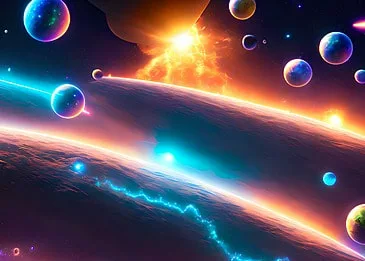We exist within the vast expanse of a galaxy called the Milky Way, a home to billions of stars that dazzle the night sky. But how did we come to this point, and what lies ahead for us? These questions extend beyond our own galaxy and encompass the mysteries of galaxies throughout the universe.
The known universe is a tapestry of 200 billion galaxies, each with its own unique characteristics, immense size, and dynamic nature. We find ourselves compelled to explore the origins of galaxies, understand their workings, contemplate their future, and ponder the eventual fate that awaits them.
If you have a fascination for captivating videos that delve into the depths of the universe, we invite you to subscribe to our channel, where we strive to keep you updated with awe-inspiring content.
The Milky Way, our very own galaxy, is approximately 12 billion years old. It stretches across space as a vast disk adorned with magnificent spiral arms and a central nucleus. However, it is merely one of countless galaxies that exist within the grand tapestry of the universe.
Galaxies are colossal gatherings of stars, forming stellar nurseries where stars are born and eventually meet their end. Nebulas, concentrations of dust and gas, serve as the cradles for star formation within galaxies. Within our own Milky Way, billions of stars illuminate the cosmic canvas, some accompanied by planets and moons. However, for the longest time, our understanding of galaxies was limited.
A century ago, we believed that the Milky Way stood as the solitary galaxy within the cosmos. It was in 1924 that astronomer Edwin Hubble revolutionized our perception of the universe. Armed with the cutting-edge 100-inch Hooker telescope atop Mount Wilson near Los Angeles, Hubble gazed into the depths of space and witnessed hazy masses of light scattered across the dark expanse. He realized these were not individual stars but entire cities of stars, constellations, far beyond the boundaries of our own galaxy.
This realization sent shockwaves through the astronomical community. Suddenly, the Milky Way was no longer the sole galaxy in the universe but one among billions. Hubble’s groundbreaking discovery forever changed the landscape of astronomy.
Take, for instance, the captivating Whirlpool Galaxy, adorned with over 160 million stars and characterized by its grand spiral arms. Or the majestic M87, an enormous elliptical galaxy whose stars radiate with a golden hue, signifying its ancient presence in the cosmic timeline.
As we continue our exploration of the universe, we uncover more marvels and mysteries that galaxies hold. Each discovery deepens our understanding of the vastness and complexity of the cosmos, propelling us to seek answers to questions that have intrigued us for centuries.
In this journey through the marvelous galaxies, we strive to unravel the enigmatic tapestry of the universe, revealing the wonders that lie within and inviting you to join us in the quest for knowledge and awe-inspiring revelations.
And this is the Sombrero Galaxy.
Its massive bright core is surrounded by a cloud of gas and dust.
All galaxies are very beautiful.
They stand in for the fundamental building block of the cosmos.
As they spin across space, they resemble enormous pinwheels.
Galaxies are enormous on a grand scale.
On Earth, we measure distance in miles.
In space, astronomers use light years.
This is how far light can travel in a year.
Our Galaxy’s diameter is over one hundred thousand light years and we’re now located at a distance of 25 000 from its Center.
However, in the grand scheme of things, even it seems like a tiny Dot.
While the Milky Way seems enormous from Earth, when compared to other galaxies it is really rather little.
Andromeda, the Galaxy closest to us, is about 200 000 light years wide, making it twice as large as The Milky Way.
M87 is the largest elliptical galaxy in our own Cosmic backyard and much bigger than Andromeda, but M87 is Tiny compared to this giant, 6 million light years across.
Ic1011 is the biggest galaxy ever found.
It’s 60 times the size of our own Milky Way.
It’s common knowledge that galaxies are enormous and ubiquitous, but why is this the case?
The origin of galaxies is a key mystery in astrophysics.
Approximately 13.7 billion years ago, the universe began with what we refer to as the big bang, a period of intense heat and density.
We know that there could not have been anything like a Galaxy at that time, so galaxies must have come from that very early universe and formed from it.
For stars to form, and for Galaxies to form from those Stars, gravity is essential.
After the big bang, the first Stars began to emerge only 200 million years later.
The earliest galaxies formed as their masses began to Clump together because to gravity.
Thanks to the Hubble Space Telescope, we can now see the early Universe, when galaxies were just beginning to form.
Numerous galaxies are visible to the Hubble.
The light we see from distant galaxies now, however, really departed those objects many millions or perhaps billions of years ago.
What we see now is the distant past of those galaxies, since it took so long for their light to get to us.
The Hubble Deep Field reveals a collection of fuzzy dots.
They are quite different from the galaxies we see now.
We can hardly make out these little specks of light.
Those fuzzy patches of light are really millions or billions of stars beginning to combine.
The oldest galaxies are represented by these barely visible blotches.
They began to take shape around a billion years after the big bang.
However, Hubble’s range of visibility ends there.
A second sort of telescope, one too large to send into space, is required if we are to travel much farther back in time.
Not only can the telescope identify primordial galaxies, but it can also Trace their evolution.
The evolution of Galaxy and Galaxy cluster formation may be followed.
All the galaxies that have developed since the Cosmos was just a few hundred thousand years old are leaving their imprints for us to observe.
Finally, scientists can begin to answer the question: what did Young galaxies look like?
Galaxies have evolved from clusters of stars to the complex web of systems we see today, and this process is being seen by astronomers.
As far as we can tell, the greatest structures in the universe today originated as star clusters, evolved into galaxies, formed clusters of galaxies and ultimately coalesced into superclusters of galaxies.
There was a lot of Stardust, gas and clumpy structures in the early galaxies.
However, modern galaxies seem organized and tidy.
When and how can Tangled clusters of galaxies become neatly organized Spirals and pinwheels?
Gravity is the explanation.
Galaxies are molded by gravity and its effects determine their fate.
At the center of most galaxies lies an unfathomably strong and distinctive gravity source, and our own Milky Way has won hidden at its core.
Over 12 billion years have passed since galaxies first appeared.
These Stellar conglomerations may take many forms, from spirals to Giant spheres of stars.
As far as we can tell, however, there is still a great deal we don’t understand about galaxies.

How did galaxies evolve into their present forms?
Did spiral galaxies always have to be spirals?
The answer is almost certainly no.
No, young galaxies are a mix of stars, gas and dust.
They are untidy and chaotic.
They begin as chaotic formations like the Whirlpool Galaxy, then, over billions of years, develop into more orderly forms.
Foreign wasn’t born from a single Galaxy, but from a cluster of several.
Our Milky Way originated as a collection of disparate formations, objects of varying sizes and shapes that gradually merged to become the Galaxy we see today.
Gravity is what binds the various components together.
Over time, it gradually draws Stars closer.
They pick up speed and flatten out into a disc shape.
Massive spiral arms gather Stardust and gas.
This process was carried out countless times during the course of the cosmos.
While visually distinct, these galaxies share the fact that they all seem to circle the same Central object.
For a long time, researchers pondered what might possibly alter a Galaxy’s Behavior, and they found out a black hole.











